Related Research Articles

Newport News Shipbuilding (NNS), a division of Huntington Ingalls Industries, is the largest industrial employer in Virginia, and sole designer, builder and refueler of United States Navy aircraft carriers and one of two providers of U.S. Navy submarines. Founded as the Chesapeake Dry Dock and Construction Co. in 1886, Newport News Shipbuilding has built more than 800 ships, including both naval and commercial ships. Located in the city of Newport News, its facilities span more than 550 acres (2.2 km2), strategically positioned in one of the great harbors of the East Coast.

The United States Shipping Board (USSB) was established as an emergency agency by the 1916 Shipping Act, on September 7, 1916. The United States Shipping Board's task was to increase the number of US ships supporting the World War I efforts. United States Shipping Board program ended on March 2, 1934.

A submarine chaser or subchaser is a small naval vessel that is specifically intended for anti-submarine warfare. Many of the American submarine chasers used in World War I found their way to Allied nations by way of Lend-Lease in World War II.

Hog Islanders is the slang for ships built to Emergency Fleet Corporation designs number 1022 and 1024. These vessels were cargo and troop transport ships, respectively, built under government direction and subsidy to address a shortage of ships in the United States Merchant Marine during World War I. American International Shipbuilding, subsidized by the United States Shipping Board, built an emergency shipyard on Hog Island at the site of the present-day Philadelphia International Airport.
The Defoe Shipbuilding Company was a small ship builder established in 1905 in Bay City, Michigan, United States. It ceased to operate in 1976 after failing to renew its contracts with the United States Navy. The site of the former company is now being developed for business and housing on the bank of the Saginaw River.

The Emergency Fleet Corporation (EFC) was established by the United States Shipping Board, sometimes referred to as the War Shipping Board, on 16 April 1917 pursuant to the Shipping Act to acquire, maintain, and operate merchant ships to meet national defense, foreign and domestic commerce during World War I.
USS West Coast (ID-3315) was a cargo ship for the United States Navy during World War I. The ship was laid down as SS War Dagger but launched in July 1918 as SS West Coast and reverted to that name at the end of her Navy service.
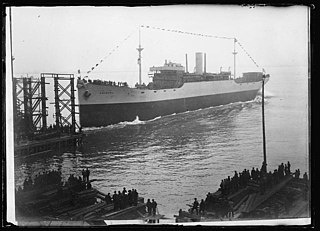
The Merchant Shipbuilding Corporation was an American corporation established in 1917 by railroad heir W. Averell Harriman to build merchant ships for the Allied war effort in World War I. The MSC operated two shipyards: the former shipyard of John Roach & Sons at Chester, Pennsylvania, and a second, newly established emergency yard at Bristol, Pennsylvania, operated by the MSC on behalf of the U.S. Shipping Board's Emergency Fleet Corporation (EFC).

USS SC-21, until July 1920 known as USS Submarine Chaser No. 21 or USS S.C. 21, was an SC-1-class submarine chaser built for the United States Navy during World War I.

USS SC-26, until July 1920 known as USS Submarine Chaser No. 26 or USS S.C. 26, was an SC-1-class submarine chaser built for the United States Navy during World War I.

USS SC-39, until July 1920 known as USS Submarine Chaser No. 39 or USS S.C. 39, was an SC-1-class submarine chaser built for the United States Navy during World War I.

USS SC-40, until July 1920 known as USS Submarine Chaser No. 40 or USS S.C. 40, was an SC-1-class submarine chaser built for the United States Navy during World War I.

The SC-1 class was a large class of submarine chasers built during World War I for the United States Navy. They were ordered in very large numbers in order to combat attacks by German U-boats, with 442 boats built from 1917 to 1919.

Hodgdon Yachts is a builder of yachts and specialized military vessels, based in East Boothbay, Maine. It is a family-run business that was founded in 1816—reputedly the oldest continuously operating family boatbuilder in the United States. Hodgdon Yachts is noted for building superyachts, both sail and power, using advanced composite materials and construction techniques. It's also noted for its ability to incorporate those advanced materials into traditional designs that employ modern electronic and mechanical marine systems. The company has several divisions—yachts, custom tenders, yacht interiors, yacht services and military composites with offices in Boothbay, Maine, Newport, Rhode Island and Monaco.
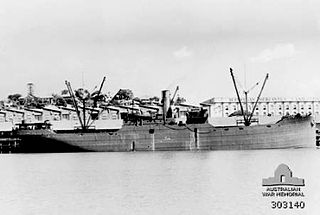
The Design 1023 ship was a steel-hulled cargo ship design approved for mass production by the United States Shipping Board's (USSB) Emergency Fleet Corporation (EFC) in World War I. Like many of the early designs approved by the EFC, the Design 1023 did not originate with the EFC itself but was based on an existing cargo ship designed by Theodore E. Ferris for the United States Shipping Board (USSB). The ships, to be built by the Submarine Boat Corporation of Newark, New Jersey, were the first to be constructed under a standardized production system worked out by Ferris and approved by the USSB.
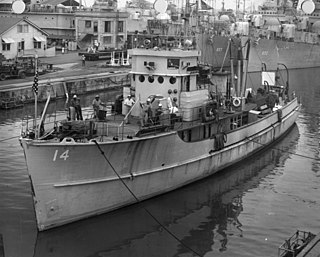
South Coast Shipyard was a shipbuilding company in Newport, California. To support the World War II demand for ships South Coast Shipyard built: minesweepers, Torpedo Boats, Submarine chasers, & Air-sea rescue boats. South Coast Shipyard was opened in 1938 by Walton Hubbard. After World War II the shipyard continued to build ships for the US Navy till 1955. The shipyard was located at 2300 Newport Boulevard, Newport, California. The shipyard closed in 1963.

Splinter fleet or Splinter navy was a nickname given to the United States wooden boats used in World War II. The boats served in many different roles during the war. These boats were built in small boatyards on the West coast and East coast, Great Lakes and the Gulf of Mexico. They could be built quickly, in just 60 to 120 days. Most of the boats were built by boatyards that already had the tools and knowledge from building yachts, sailboats and motor boats. Many were built by craftsmen in family-owned small businesses. Under the Emergency Shipbuilding Program and War Shipping Administration contracts went out to over fifty boatyards across the country. The boats were built for the US Navy, the, United States Army Air Forces, United States Coast Guard, and US Army. Some of the wooden boats went to Allied nations on the Lend-Lease program.
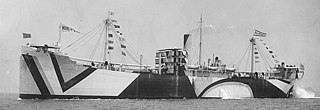
The Design 1015 ship was a steel-hulled cargo ship design approved for production by the United States Shipping Board's Emergency Fleet Corporation (EFT) during World War I. They were referred to as the "Moore & Scott"-type.
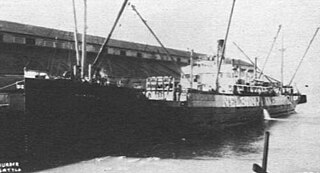
SS Arcata, was built in 1919 as the SS Glymont for the United States Shipping Board as a merchant ship by the Albina Engine & Machine Works in Portland, Oregon. The 2,722-ton cargo ship Glymont was operated by the Matson Navigation till 1923 in post World War I work. In 1923 she was sold to Cook C. W. of San Francisco. In 1925 she was sold to Nelson Charles Company of San Francisco. In 1937 she was sold to Hammond Lumber Company of Fairhaven, California. For World War II, in 1941, she was converted to an US Army Troopship, USAT Arcata. She took supplies and troops to Guam. On July 14, 1942, she was attacked by Japanese submarine I-7 and sank. She was operating as a coastal resupply in the Gulf of Alaska, south of the Aleutian Islands at, approximately 165 nautical miles southeast of Sand Point, when she sank. She was returning after taking supplies to Army troops fighting in the Aleutian Islands campaign.
The George F. Rodgers Shipbuilding Company was a shipbuilder located in Astoria, Oregon.
References
- 1 2 "New Lifeboat Arouses Worldwide Interest". The World News . April 5, 1917. p. 2 – via Virginia Chronicle.
- 1 2 3 4 5 "Forgotten Shipyard in Hampton Was Part of World War I effort To Halt Threat of Germany's Infamous U-Boats" (PDF). subchaser.org. August 3, 2009.
- 1 2 3 4 5 6 7 8 9 Reeves, Carol Buck (January 1944). Settlement of Claims Arising Under cancelled War Contracts 1918-1926 - Illustrated With Six Case Studies, Division of Historical Studies of Wartime Problems, Impact of World War I On The Hampton Roads Area. United States Department of Labor - Bureau of Labor Statistics. pp. 7–9.
- ↑ McKellar, Norman L. "American Wooden Shipbuilding in World War One, Part II" (PDF). American Wooden Shipbuilding in World War One, 1917-1921. ShipScribe. p. 338.
- 1 2 3 4 5 6 "SC-201 through SC-300". Dictionary of American Naval Fighting Ships. Retrieved 5 June 2015.
- ↑ Colton, Tim (August 31, 2021). "Newcomb Lifeboat". shipbuildinghistory.com.
- ↑ "Hull Number: SC 219". The Subchaser Archives